
|
Flash Units for E-System Cameras |

|
My other articles related to the |
|
Built-in flashes in cameras are never powerful enough for any real use, except in emergencies, or as a source of fill-in light. The E-1 does not have an internal flash at all (it wouldn't fit a "serious" camera, and, besides, it would be hard to weatherproof). In either case, most of us will need an external flash unit. This article gives the basic information of using an external flash with S-System cameras, including the E-510, E-410, E-500, E-330, E-300 and E-1. I'll be referring to both Olympus and third-party, non-dedicated models. External flash units can be divided into five major groups; let me follow this division in my write-up. One: Dedicated Olympus flashes These provide full integration with the TTL flash metering of the camera (the "TTL Auto" mode), also adding (except for the FL-20) other niceties. Another two fully-integrated units by Olympus, intended mostly for close-up and macro work, are described in a separate section at the end of this page. | |
|
FL-50, the flagship of the line. This powerful unit has bounce, swivel, and motorized head zoom, reacting to the lens focal length. It also provides the multi-burst, high-speed "FP mode" which allows for a focal plane synchronization at all shutter speeds. Besides the obvious, this unit includes many smaller touches in how it co-operates with the camera. For example, it reacts to the camera being powered off, or to the top display (E-1) illumination being turned on. Additionally, the FL-50 can be powered from the FP-1 power grip and/or the HV-1 high-voltage power pack, providing up to 700 full flashes and recharge times as short as 1.3 seconds. |
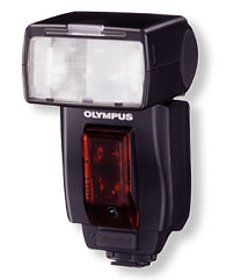
|
|
FL-36, the kid brother, is smaller, powered by only two AA's, and offers less light output. Otherwise it shares all bells, whistles, and thoughtful touches of the FL-50 except for accepting alternate power sources. The folding, built-in wide-angle diffuser is quite ingenious, too. This is a very capable unit, and I like it a lot. It may be the most attractive option for all except the "power users" and professionals. It is certainly good enough for me. See my separate FL-36 review. |
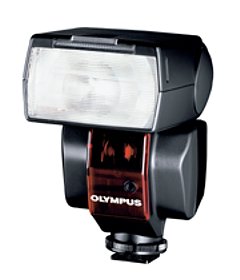
|
|
FL-20, also powered by two AA's, is a real midget, smaller than a pack of cigarettes, but still offering four times more output than the built-in flashes. It does not bounce, swivel, or zoom, and it does not offer the multi-burst, high-speed synchronization. It does, however, integrate with camera's TTL metering circuitry. While this is not enough of a flash for serious applications, the FL-20 may find its uses. It is small enough to be tossed in a corner of your camera bag (or carried in your pocket) to provide emergency light; it also can come handy in providing fill-in in outdoors shooting. I bought one just for those occasions, and you can see a write-up in my C-5050/5060 section. |
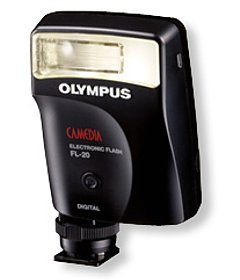
|
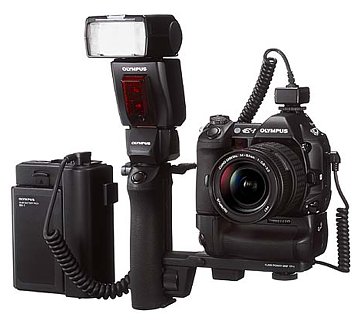
|
The FL-50 has a dual personality: when used on the camera's hot shoe, it pretends to be a high-end, capable and integrated amateur unit, very much like an FL-36, but with more light output. With the extra power accessories it becomes a serious, working pro's tool. I have played with the FL-50 only for a day (and without all the accessories), but this was enough to leave me most impressed. Shown: E-1 with the 14-54 mm zoom and HLD-2 battery holder, FL-50 flash mounted on the FP-1 power grip, SHV-1 high-voltage power set, and three cables as needed to wire the whole shebang together (power, flash, remote release). This may become my favorite hiking outfit. (All equipment photos in this page by Olympus) |
|
The older Olympus FL-40 flash presents a more complicated situation.
Two: Dedicated units by other makers Some independent manufacturers offer flashes supposed to support Olympus data interchange standard; most achieve the goal by providing interchangeable, camera-specific interface modules for their units. Un the past I have checked such flashes by Metz and Promaster, with positive results. Things are not so simple, though. With the E-1, Olympus changed the interface standard: new flashes work with older cameras, but not vice versa. This means that a third-party flash which worked fully integrated with the E-20 or C-5060WZ may, and probably will not, work in the TTL mode with E-System cameras. Frankly speaking, I haven't researched this subject, so I cannot offer any specific information. If you want a third-party dedicated flash, make sure that the maker explicitly states its full dedicated capability with the E-Sstem cameras more recent tham E-1, otherwise you may end up with a non-dedicated, thyristor unit. (Those also are capable of good results without too much effort, but why pay extra for a "dedicated unit" then?) Anyway, do not ask me about compatibility of any specific model — I just don't know. Three: Non-dedicated, auto-exposure units These units will synchronize with the camera, but with the light metering done by the flash itself, using its own, external sensor. The camera has to be set to manual exposure mode, with the aperture as required by the flash and any speed up to 1/320 s (the official Olympus high-speed limit is 1/180 s, but I was able to verify the 1/320 s with the E-300, E-500, and E-510). Most of currently available third-party, non-dedicated flashes belong to this group, and you can get a working flash solution for as little as $20, or a quite sophisticated, two-burner one for just $80. Flashes in this group I've tried with the E-300 include FL-40 by Olympus (with the E-1 it belongs to Group One, see above), the tiny Sunpak DS20, and a flash with the inventive name of 92ATBSZ sold as a house brand by Adorama. Once again, treat these just as examples, as all of current thyristor models should also work fine with the E-300 or E-1. In all cases, the voltage visible on the flash synch contacts is recommended to be not more than 10-12V. While Olympus says the circuitry is safe to use with voltages up to 250V, I wouldn't risk it. (If a flash was made in the last six years or so, the chances are that it will be of the low synch voltage type, but you may use a voltmeter to check.) Four: Non-dedicated, manual These will also synchronize OK, but are not capable of exposure metering; the camera has to be set to manual exposure mode, with any speed as above, and aperture — calculated by dividing the flash guide number (GN) by distance. There are very few flashes of this type recently made (except for some specialized ones for professional use), so I don't think you will come across one. My warning above, regarding the trigger voltage, is also applicable here! Five: Totally incompatible These may be flashes dangerous to use because of high synchronization voltage (see above), or incompatible for any other reason (I find it hard to think of one). If you come across a flash unit (not advertised as Olympus-compatible, that is) with extra pins in the foot (besides the central, usually bigger one used for triggering), do not try to use it. It was designed for another camera line, and the extra pins are used to communicate with that camera. In the best case they will be ignored, with less luck they may damage your camera's circuitry. Appendix: Olympus macro flash units Note: as opposed to the above, I haven't used either of the units described in this section. Treat it therefore as a compilation of data, obtained from Olympus literature (including user manuals), grapevine, smoke, and mirrors. When and if I get one of these (and I'm very tempted with the ring light!), I will add more information and my impressions to this section, maybe write a separate article. Olympus offers what seems to be a very complete and attractive macro flash system. While some of individual pieces can be bought separately, the alternatives boil down to two (not mutually exclusive) setups. | |
|
The SRF-11 Ring Flash Set — consists of two basic parts: the ring light (burners with modeling lights) itself, and the flash controller. The ring light fits on the hood bayonet of the ZD 14-54 mm zoom lens, or, with an optional (and outrageously priced!) adapter, on the ZD 50/2.0 macro lens. The controller gets into the camera's hot shoe; it contains all necessary control circuitry and power supply. Both are connected with a supplied cable. Full TTL exposure automation is provided, very much like in the FL-50 or FL-36. |
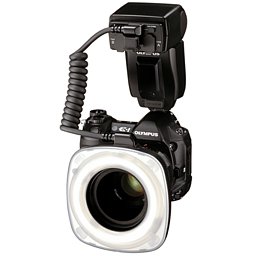
|
|
The STF-22 Twin Flash Set uses the same controller, but instead of the ring light it has a lens adapter ring with two burners, each connected to the controller with its own cable. The light ratio between both burners can be widely adjusted, and there are even diffusers available to soften the light. (Lens support is also limited to the two as above.) Again, the STF-22 is fully integrated with the camera, including full TTL exposure automation. |
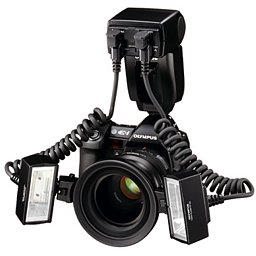
|
|
As both setups share the same controller, they are also available without it, as RF-11 and TF-22 ("s" stands, obviously for "set"). The controller, however, FC-1, is not available separately, at least not in the States. It looks very smart, and even can use the HV-1 high-voltage power pack (see the FL-50 above). If you are ready to use one of these, you probably do not need to read this article, anyway. The Asian Olympus E-System Web site (useful, complete, easy to navigate — did they hire somebody new?) offers the full specifications and even user manuals. Going through those made me quite impressed; I would love to try one of the macro units out! | |

|
My other articles related to the |
|
Evolt® and Olympus® are registered trademarks of Olympus Corporation.
This page is not sponsored or endorsed by Olympus (or anyone else) and presents solely the views of the author. |
| Home: wrotniak.net | Search this site | Change font size |
| Posted 2005/08/10; last updated 2007/08/05 | Copyright © 2005-2007 by J. Andrzej Wrotniak. |